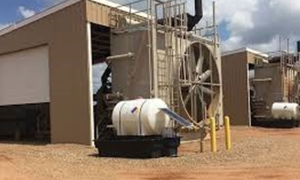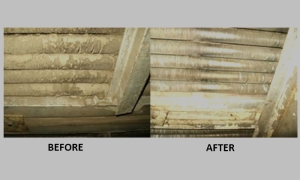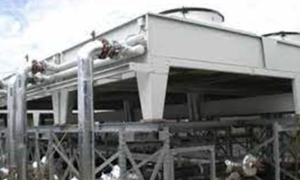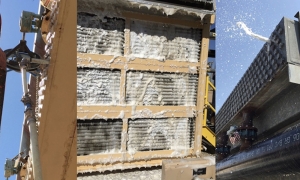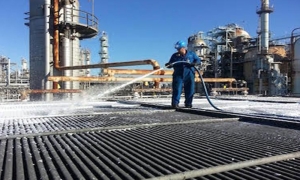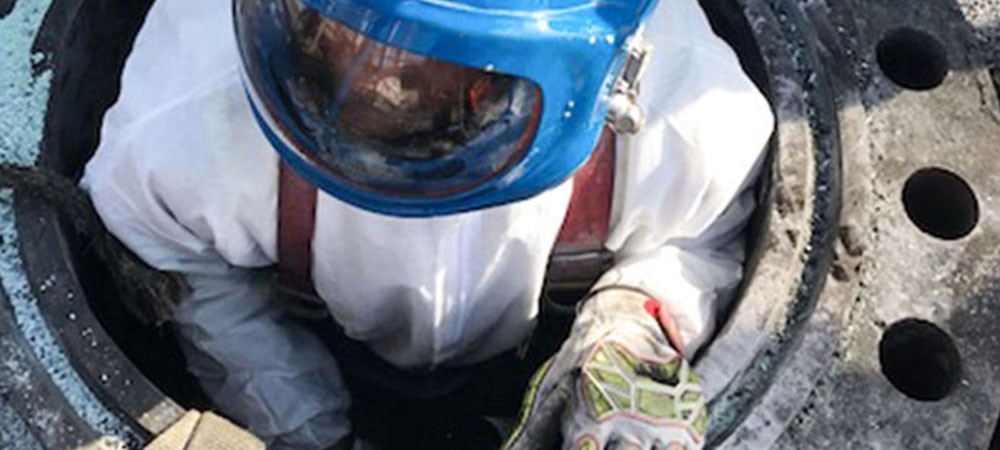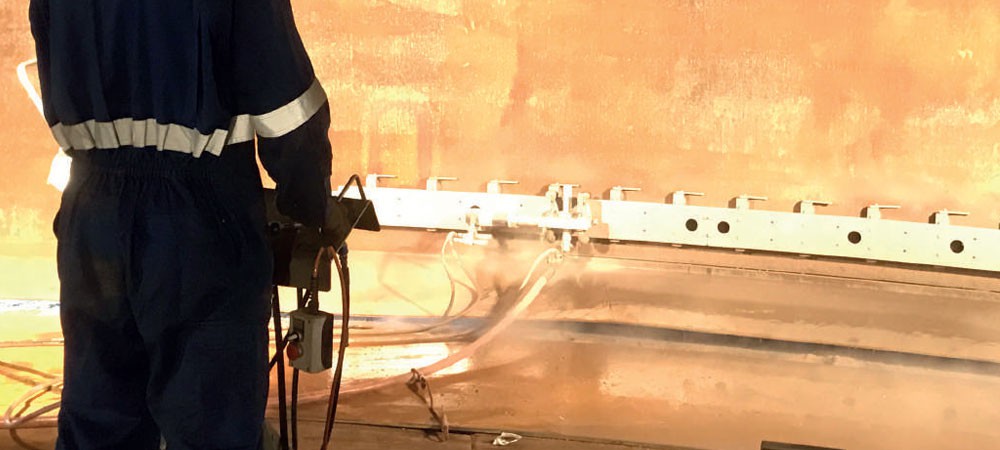Fin Fan Cleaning
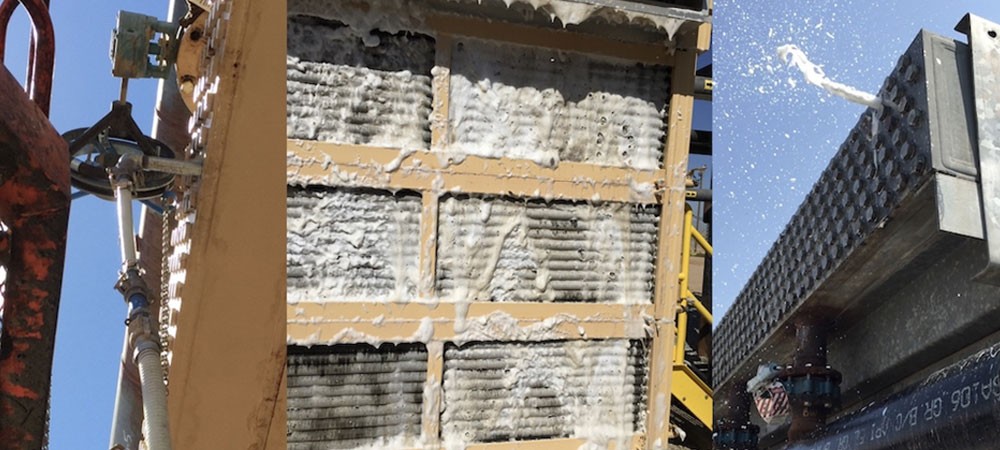
Fin Fan Cleaning
Our foaming fin fan and heat exchanger cleaning chemicals effectively clear any contaminants. Follow the steps below to achieve the best results:
- Turn off and tag out fin fans.
- Block in fin fan inlets and let cool.
- Work with a contractor to set up containment if required.
- Tape off the area below the fin fans to avoid showering people.
- Inset ARO pump into the drum. Connect the air hose to the pump and connect the soap hose to the pump. If at ground level or choose not to utilize a pump, a soap picks up tube may be used instead.
- Connect air, soap, and water hoses to foam.
- Connect the discharge line to the foamed.
- Adjust soap, air, and water settings until a thick foam is discharged. (These will be minor adjustments) The water was turned on first prior to the air to avoid hose bucking.
- Foam each bank or shroud enclosure from above, making sure to cover the whole area evenly. Use approximately 20 gallons per fan cold or 30 gallons per fan hot.
- Allow foam to sit and drip through fin fans for 10 to 20 minutes.
- Rinse thoroughly using a high-volume water hose.
- Perform housekeeping and clear the area of tap and foam equipment.
We recommend using the equipment below for application and safety:
- Super foamed (Available for rent or for purchase)
- ARO pump
- High-volume water hose
- Air and fluid hoses
- Caution tape
- Safety glasses
- Safety goggles
- Rubber gloves
- PPE appropriate for the area
Beat the heat limitations and do fin fan cleaning online or offline. EMBARK has been successfully utilized to clean fin-fan ODs while units remain online. By alternating fans and utilizing heavy-duty cleaners, our customers use a foam cleaning procedure that cleans ODs while the unit continues to run. They have experienced as much as a 40-degree improvement with an average of about 25 to 30-degree improvement. The procedure uses a very small amount of liquid and produces copious amounts of foam.
- Cleaning of the tube exteriors will not require entry into the shrouds.
- No damage to tubes by personnel entering the shrouds and walking on the Aluminum tubes.
- No damage by improper use of high-pressure water, which may bend the Aluminum fins.
- Deep cleaning of the interiors of the tube banks that cannot be done in a water wash.
FIN FAN CLEANING SERVICES
Dirty fin fan coils reduce the cooling efficiency of heat exchangers. FIN FANs' low-pressure, high-volume cleaning process removes dirt and debris safely and thoroughly. Cooling equipment begins performing at an optimal level and the results bring multiple financial benefits. Clean exchangers result in fewer energy requirements allowing fans to be turned off or run more slowly. Equipment life is extended and most importantly, production can be increased where cooling has been detrimental to output.
FIN FAN cleans blocked heat exchanger fins. Dirty fins restrict airflow through the exchanger unit causing a significant drop in cooling efficiency and a loss in production. An environmentally friendly foam cleaner and low-pressure rinse remove dirt, oil, and debris from the entire heat exchanger unit. FIN FAN's process has been tested and proven in industrial facilities throughout the world.
A cleaning process that is eco-friendly, safe, rapid, and thorough.
Our technicians use an environmentally friendly chemical foam that saturates and expands into every crevice of the heat exchanger. A low-pressure rinse minimizes overspray and is safer for both personnel and equipment. The traditional cleaning method (hydro blasting) damages delicate fins and compacts the debris into the center of the tube stack. Our process completely removes dirt, debris, and corrosive elements without damaging equipment. FIN FAN has been tested and proven in industrial facilities throughout the world.
Fin fans and air-cooled condensers are critical components in maintaining the smooth running of many industrial processes across oil refineries, petrochemical, and the energy sector.
- Reduced energy costs in powering the fans due to the improvement in cooling efficiency
- Improved production rates were inefficient cooling demands lower throughput.
- Prolonged unit life through reduced corrosion risk and preventative maintenance to minimize equipment loading.
With EMBARK technology we use our specialized dry, soluble, crystal media to decontaminate and clear the externals of the most challenging air-cooled condensers. Our media is delivered at low pressure using compressed air to gently sweep the media across the fins to dislodge environmental contaminants.
Unlike aggressive methods such as water blasting this presents no risk of damaging the fin fans. Our operators can clean the fans from the bottom-up meaning that there is no need for scaffolding or other temporary platforms. This has two major benefits, as the operators can work underneath the fans there is no chance of them damaging the delicate Fins by standing on them. Secondly, our operators do not need access to the plenum chamber, and this reduces the hazards faced by workers.
The method is non-hazardous, REACH compliant, compatible with all metallurgies, and environmentally safe. The levels of performance restoration gained over previously employed water jetting methods mean we see repeat orders year after year for this.
FIN FAN CLEANING SERVICES
Fin fans are environmentally friendly coolers that play a vital role in the energy, oil, gas, and chemical industries but they need experts such as EMBARK to ensure they run as efficiently as they possibly can.
These industrial processes generate heat from both liquids and gas and the fin fans known as heat exchangers - cool this heat down before sending it into the air. They are a way more environmentally friendly process than using water-cooled systems or giant cooling towers.
Even better, when EMBARK clean your fin fans to ensure the condensers inside them keep running at optimum performance they can do it while the industrial process continues so there is no need to shut down the plant and no disruption on production at all. If they have become dirty or clogged, once EMBARK has cleaned your fin fan you will see improved cooling and a much better overall performance.
Other companies use high-pressure water jets or foam to clean the fin fans but powering water at them can damage the fins some can be quite delicate - while foam will leave a lot of waste and mess to clean up.
EMBARK has perfected its own cleaning system that blasts the fin fans clean using low-pressure air to get rid of all the debris from the fin fans. The system is in a mobile trailer which EMBARK's expert cleaning operators simply park up and plug in so they can get straight to work.
The setup is minimal, and they can work in isolation with no need to meet anyone else on site which is very important during the coronavirus pandemic. EMBARK has also been providing a vital frontline service to provide essential deep cleaning services during the Covid 19 crisis.
A fin-fan is a type of heat exchanger that forces hot air over a set of coils to cool the process and is also known as an air-cooled heat exchanger.
They are used when an industrial process produces heat that cannot be reused so needs to be removed. It is the same theory you see on your car radiator with hot air produced by the engine forced through a grille of fine tubes which dissipates the heat.
Of course, fin fans used in the energy, oil, gas, and chemical industries can be on a massive scale and they need to be always kept in good working condition.
A typical air-cooled exchanger consists of a finned-tube bundle. A fin tube is a tube with small fins on the outside surface which act to transfer heat generated during the process into the atmosphere. The air is forced across the tube bundle by fans powered by electric motors and the fins increase the contact area to make the process more effective and efficient.
Air-cooled heat exchangers make sure the hot air they are expelling is not hazardous to anyone or anything such as buildings or nearby equipment that could be damaged by the heat.
Air-cooled heat exchangers are used widely in the oil and gas industries, particularly refineries and petrochemical plants, along with industrial processes involving corrosive fluids. These are industries that use high-pressure and high-temperature procedures in their processes.
FIN FAN CLEANING SERVICES
A fin fan is a heat exchanger that forces air over a set of finned tubes to cool the medium inside the tube. Although their applications can differ, fin fan style radiators can also be designed as steam condensers known as Apex Air Cooled Condensers.
Fin fans are widely used in oil and gas, petrochemical and polymer, power and energy, and manufacturing industries. The main function of fin fans is to remove heat produced by an industrial process that cannot be reused.
A fin fan heat exchanger is a critical asset and should be regularly maintained to ensure optimum performance.
The fin fan unit should be cleaned dependent on the environment. Debris is drawn into the unit from the air used for cooling. For example, a steelworks or waste-to-energy plan is more likely to have a dusty environment and require additional monitoring and maintenance.
Cleaning schedules are often dictated by measuring performance and cleaning when there is a drop in efficiency. On average, fin fans should be cleaned 1-2 times per year, depending on the environmental factors and performance analysis.
A dirty or fouled fin fan unit can significantly reduce efficiency and output, regardless of plant size. If fin fans are fouled, they are not able to cool effectively or as quickly as required. Eventually, underperforming units will lead to a reduction in throughput or unplanned outages and affect the bottom line.
Fouling in fin fan units is caused by environmental debris being drawn into the unit with the airflow.
Furthermore, warm ambient temperatures can exacerbate the issue of fouling. The cooling medium used by the fin fan (air) will be warmer upon entering the unit, reducing the effectiveness of the cooling process. When fouling is removed from the asset, the radiator recovers surface area for designed cooling.
